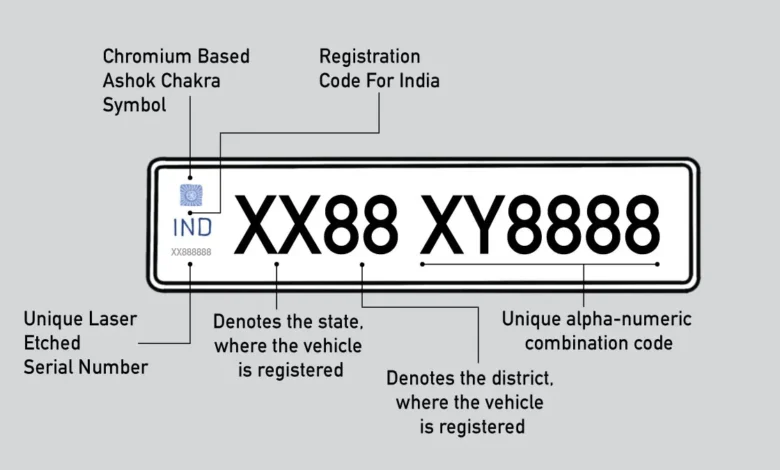Number Plates and Car Age Tips

Ever been stuck in traffic and found yourself playing that peculiar British game of “guess how old that car is” just by glancing at its number plate? If you’ve nodded along thinking, “Yep, done that,” you’re not alone. Our registration plates tell stories – sometimes ones we’d rather keep quiet about our ageing vehicles!
Let’s decode the secret language of UK registration plates and find out how old your number plate is without needing to be a vehicle expert or carry around a cheat sheet.
The Evolution of the British Number Plate: A Quick History Lesson
The earliest plates from 1903 were beautifully simple – just a letter or two followed by numbers. Spotting one of these vintage registrations today usually means you’re looking at either a very old vehicle or someone with deep pockets who’s purchased a cherished transfer.
As vehicle ownership exploded throughout the 20th century, the system evolved to accommodate the growing number of cars. By the 1950s and 60s, we saw suffix registrations appear – those with a letter at the end indicating the year of registration. The 1970s flipped this to prefix registrations with the year letter at the beginning.
Both these systems ran through the alphabet year by year (though some letters like I, O, U and Z were held back to avoid confusion or unfortunate combinations). This worked well enough until we started running out of combinations – a nice problem to have if you’re selling cars!
Current Style Plates: The Code Everyone Can Crack
In September 2001, the DVLA introduced our current system, which cleverly refreshes itself twice a year. Twenty-plus years on, most vehicles on British roads sport these plates, and they’re remarkably easy to decipher once you know the trick.
Breaking down a modern plate like BD21 SMR:
● The first two letters (BD) indicate where the vehicle was registered – in this case, Birmingham
● The two numbers (21) tell you when it was registered – the age identifier
● The last three letters are randomly assigned to make each plate unique
Those middle numbers are your age giveaway, changing every March and September. This creates our familiar pattern:
● March to August – the year number itself (e.g., 21 for 2021)
● September to February – the year number plus 50 (e.g., 71 meaning late 2021)
“But hang on,” I hear you ask, “what happens after 99?” Good question! When we hit March 2050, the system will need another refresh. Perhaps by then, we’ll all be in flying cars with entirely different registration schemes!
Regional Identifiers: The Geographical Fingerprint
Those first two letters aren’t random either – they’re like a birthplace certificate for your vehicle. Each DVLA office has specific letter combinations assigned to them:
● LA-LY: London
● MA-MY: Manchester
● BA-BY: Birmingham
● CA-CY: Cardiff
This geographical coding adds another layer of interest to plate-spotting. That Scottish car with an “SJ” prefix? It’s proudly telling you it began life in Glasgow.
Dateless and Cherished Plates: The Age-Disguisers
Not everyone wants their vehicle’s age advertised to the world. Enter dateless and cherished number plates – the automotive equivalent of lying about your age and getting away with it.
These plates don’t follow standard age-identifier formats and include:
● Pre-1963 registrations that didn’t encode dates
● Personalised combinations that spell words or names
● Special formats like diplomatic or military plates
Spotting a modern car with a dateless plate usually means someone has invested in hiding their vehicle’s age or creating a personalised statement. Either way, they’ve thrown a spanner in your car-age-guessing game!
When Plates Lie: The Transfer System
“Wait a minute – I saw a 2015 Fiesta with an ’06’ plate last week. Your system must be wrong!”
Not so fast! The UK allows registration transfers between vehicles (with certain restrictions), meaning plates can move from older cars to newer ones – though never the other way around for obvious reasons.
This creates those head-scratching moments when the plate and car clearly don’t match up age-wise. Either someone’s transferred an older plate to a newer car, or they’ve splashed out on a personalised combination.
The Practical Benefits of Knowing Your Plate’s Age
Beyond winning trivial pub debates, understanding number plate ages has practical applications:
● Buying used cars: Spot mismatches between claimed age and plate instantly
● Insurance considerations: Some policies are affected by vehicle age
● MOT requirements: Knowing when a vehicle first needed testing
● Emissions standards: Different age vehicles meet different environmental criteria
● Vehicle value assessment: Quick age identification helps with pricing
Exceptions and Special Cases: Because Nothing’s Ever Simple
Just when you think you’ve mastered the system, along come the exceptions:
● Northern Ireland has its unique registration system
● Diplomatic vehicles use special formats beginning with ‘D’ or ‘X’
● Military registrations have their own conventions
● Historic vehicles may have period-appropriate plates reissued
Personalised Plates: When Age Doesn’t Matter
For some drivers, disguising their car’s age is precisely the point of investing in a personalised plate. Others simply want something memorable or meaningful, regardless of age implications.
Common personalised plate styles include:
● Name-based combinations
● Job or hobby references
Humorous messages





